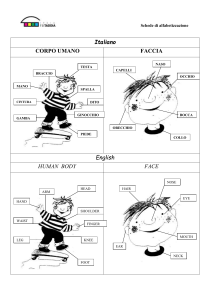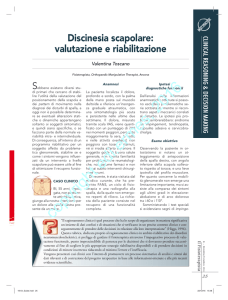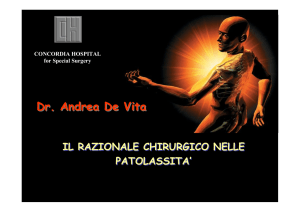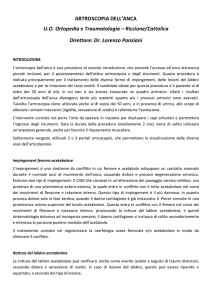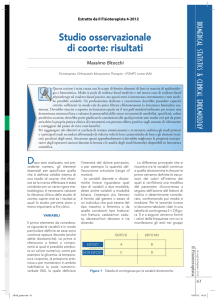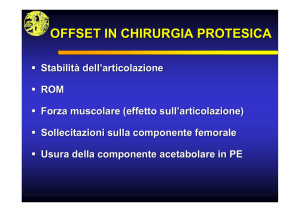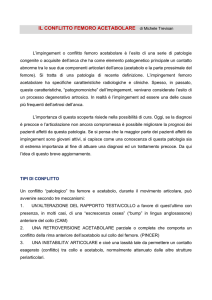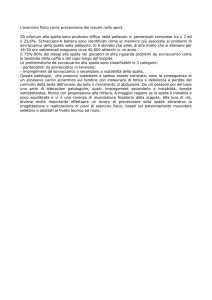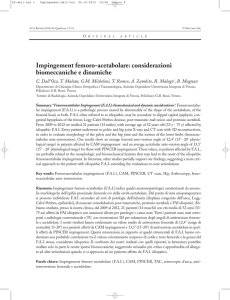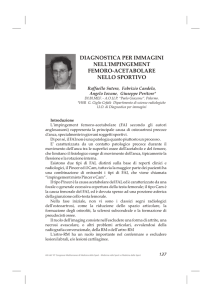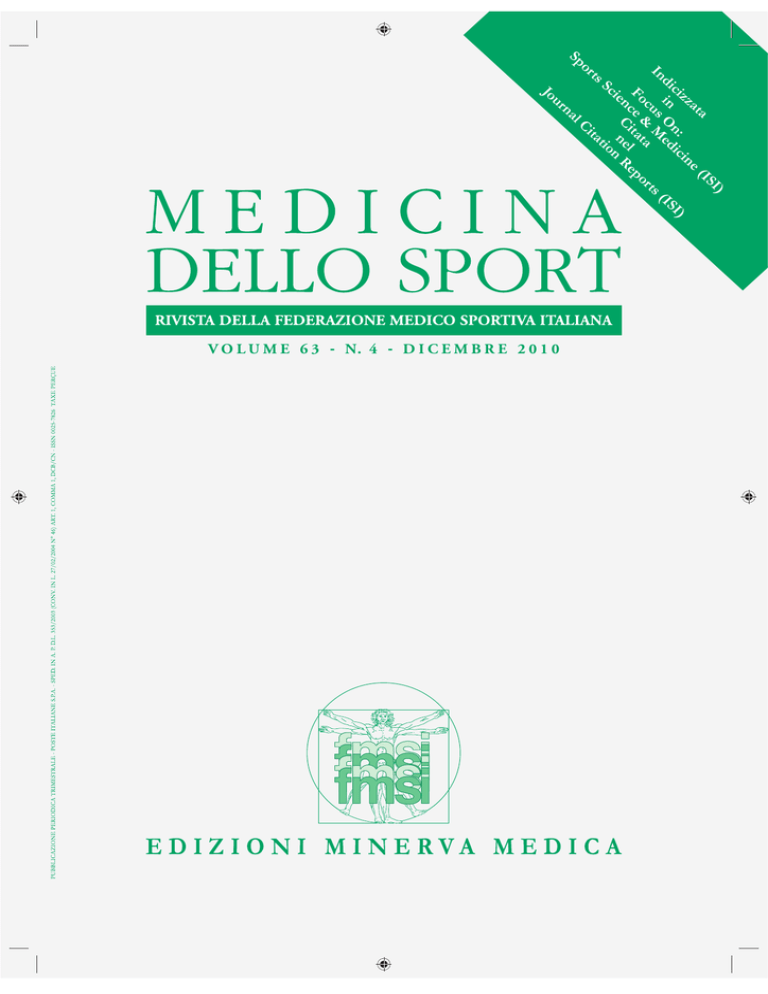
rts
Ci
)
SI
a
(I
e
at
in
zz
)
ci
n: ic
SI
di i n O d
e
(I
s
In
rts
cu M a
&
Fo ce itat l epo
e
n
i e C n on R
Sc
ti
ta
o
Sp
l
na
ur
Jo
V O L U M E 6 3 - N. 4 - D I C E M B R E 2 0 1 0
Orthopedic area
Area ortopedica
MED SPORT 2010;63:547-56
Role of MR arthrography in shoulder
micro-instability: personal experience
Ruolo dell’artro-RM nella micro-instabilità di spalla:
nostra esperienza
G. FRANCAVILLA 1, R. SUTERA 2, A. IOVANE 2, F. CANDELA 2,
A. SANFILIPPO 3, V. C. FRANCAVILLA 2, M. D’ARIENZO 3
1Department
of Clinical Medicine, Cardiovascular and Nephro-Urological Diseases
University of Palermo, Palermo, Italy
2DIBIMEF - Section of Radiological Sciences, University of Palermo, Palermo, Italy
3Clinic of Orthopaedic and Trauma, University of Palermo, Palermo, Italy
SUMMARY
Aim. Glenohumeral instability has been classically divided into two broad categories: on the one hand the socalled TUBS (Traumatic, Unidirectional, Bankart lesion, responds to surgery) and on the other AMBRII (Atraumatic,
Multidirectional, Bilateral, responds to rehabilitation, inferior capsular shift, interval closure). However, between
these two extremes there is a set of conditions defined as “minor instability”, including AIOS (Acquired Instability in
overstressed shoulder, Surgery) and AMSI (Atraumatic Minor Shoulder Instability). The aim of this study was to assess
the ability of the MR arthrography examination to detect minor shoulder instability, later confirmed by arthroscopic
examination.
Methods. MR arthrography was used to study 14 patients, who were later submitted to arthroscopic surgery of the
shoulder. We used an MRI scanner with high field strength (1.5 Tesla), and for each patient performed SE T1-weighted
sequences with and without fat signal suppression, SE-T2-weighted sequences with fat signal suppression, GRE, and
an additional T1-weighted sequence was acquired in the ABER (Abduction and External Rotation) position.
Results. MR arthrography revealed the presence of an alteration in the normal anatomy of the shoulder in all 14
patients. In all cases arthroscopic examination confirmed the findings of MR arthrography. The structural abnormalities which might result from microtraumatic glenohumeral instability may be described with MR arthrography. MR
arthrography can be used to confirm the diagnosis of a PSI and thus determine the choice of proper treatment, demonstrating the extent of joint damage. MR arthrography plays a less important role in the study of AMSI than in the
study of AIOS, as clinical aspects are more fundamental for the recognition of the cause of shoulder pain typical in
patients who neither suffered trauma nor practiced so-called “overhead” sports.
Conclusion. MR arthrography can play an important role in evaluating the shoulders of athletes, especially those
engaged in “overhead” activities, if the aim is to provide essential information for treatment decisions at a level on a
par with that of diagnostic arthroscopy.
KEY WORDS: Arthrography - Shoulder joint - Joint instability.
RIASSUNTO
Obiettivo. L’instabilità gleno-omerale è stata classicamente suddivisa in due grosse categorie: da una parte vi sono
le cosiddette TUBS (Traumatic, Unidirectional, Bankart lesion, responds to Surgery) e dall’altra invece le AMBRII
(Atraumatic, Multidirectional, Bilateral, Responds to rehabilitation, Inferior capsular shift, Interval closure). Tuttavia,
tra questi due estremi esiste un insieme di patologie che vanno definite “instabilità minori”, tra cui le AIOS (Acquired
Instability in Overstressed shoulder, Surgery) e le AMSI (Atraumatic Minor Shoulde rInstability). Scopo del presente
studio era quello di valutare la capacità di detezione da parte dell’esame artro-RM di un quadro di instabilità minore
di spalla, successivamente confermato all’esame artroscopico.
Vol. 63 - N. 4
MEDICINA DELLO SPORT
547
Metodi. Abbiamo sottoposto ad esame artro-RM 14 pazienti che, successivamente, sono andati incontro ad artroscopia di spalla. È stata usata una macchina RM a elevata intensità di campo (1,5 Tesla), e sono state eseguite per
ogni paziente scansioni SE-T1 pesate senza e con soppressione del segnale del grasso, SE-T2-pesate con soppressione
del segnale del grasso, GRE e un’ulteriore sequenza T1-pesata è stata acquisita in posizione ABER (ABduction and
External Rotation).
Risultati. L’artro-RM ha riscontrato la presenza di un’alterazione della normale anatomia della spalla in tutti e 14 i
pazienti. In tutti i casi l’esame artroscopico ha confermato i reperti artro-RM. Le anomalie strutturali conseguenti a una
instabilità microtraumatica gleno-omerale possono essere descritte alla artro-RM. L’artro-RM può essere utilizzata per
confermare la diagnosi di un PSI e così determinare la scelta del corretto trattamento terapeutico dimostrando l’estensione del danno articolare. L’artro-RM ha un ruolo meno importante nello studio delle AMSI rispetto allo studio delle
AIOS, in quanto la clinica è più significativa nel riconoscimento della causa di dolore della spalla tipico in pazienti che
non abbiano subito traumi né praticano sport cosiddetti “overhead”.
Conclusioni. L’artro-RM può giocare un ruolo importante nella valutazione della spalla degli atleti, specie quelli praticanti attività “overhead”, se mira a fornire informazioni essenziali per le decisioni terapeutiche ad un livello pari a
quello dell’artroscopia diagnostica. t
PAROLE CHIAVE: Artrografia - Spalla, articolazione - Articolazione, instabilità.
O
n the basis of a number of anatomic and
arthroscopic studies and using imagebased diagnosis techniques such as arthrography with magnetic resonance (MR arthrography), in the last ten years our understanding of
the biomechanics and physiopathology of painful shoulder in athletes has improved significantly.1-9 Various pathological mechanisms have
been identified that could not be explained
with traditional concepts of instability and impingement.10
Traditionally, gleno-humeral instability has
been subdivided into two broad categories: on
the one hand so-called Traumatic, Unidirectional, Bankart lesion, responds to Surgery (TUBS)
and on the other Atraumatic, Multidirectional,
Bilateral, Responds to rehabilitation, Inferior
capsular shift, Interval closure (AMBRII).
Although very useful in guiding the orthopedic surgeon towards correct treatment, this
classification does not include all types of instability, and in particular it does not include the
various types of microinstability.
Patients with TUBS have typical anatomopathological lesions, in particular a Bankart
cartilage or bone lesion associated with a HillSachs or a Cooper-McLaughlin lesion or an Anterior Labroligamentous Periosteal Sleeve Avulsion (ALPSA) type lesion.
Patients with AMBRII, on the other hand, do
not present real structural lesions of the glenohumeral joint, but an increase in capsular volume associated with laxity of the capsulo-ligamentous structures.
It is clear that this classification cannot in-
N
ell’ultimo decennio, grazie a diversi studi
anatomici, artroscopici e mediante uso di
tecniche di diagnostica per immagini come l’artrografia con risonanza magnetica (artro-RM),
la comprensione della biomeccanica e della fisiopatologia della spalla dolorosa degli atleti è significativamente migliorata 1-9. Infatti, sono stati
identificati diversi meccanismi patologici che non
potevano essere spiegati coi tradizionali concetti di
instabilità e di impingement 10.
Tradizionalmente, l’instabilità gleno-omerale
è stata suddivisa in due grosse categorie: da una
parte vi erano le cosiddette TUBS (Traumatic, Unidirectional, Bankart lesion, responds to Surgery)
e dall’altra invece le AMBRII (Atraumatic, Multidirectional, Bilateral, Responds to rehabilitation,
Inferior capsular shift, Interval closure).
Questa classificazione, seppure molto utile nel
guidare l’ortopedico verso un corretto trattamento,
non include tutti i tipi di instabilità, in particolare
le microinstabilità.
I pazienti con TUBS hanno lesioni anatomopatologiche tipiche, in particolare una lesione di
Bankart cartilaginea o ossea associata ad una
lesione di Hill-Sachs o di Cooper-Mc Laughlin, oppure una lesione tipo ALPSA (Anterior Labroligamentous Periosteal Sleeve Avulsion).
I pazienti con AMBRII, invece, non presentano
lesioni strutturali vere e proprie a carico dell’articolazione gleno-omerale, ma un aumento del
volume capsulare associato ad una lassità delle
strutture capsulo-legamentose.
È chiaro come tale classificazione non possa
comprendere quadri di microinstabilità di atleti
che svolgono attività “overhead” (lanciatori, pallanuotisti, pallavolisti, tennisti, ecc.) o di persone
che ritornano all’attività fisica dopo un periodo
di immobilizzazione forzata, e pertanto è stata
clude microinstability pictures in athletes who
engage in overhead activities (throwers, water
polo players, volleyball players, tennis players,
etc.) or people returning to physical activity
following a period of forced immobility, and it
has therefore been updated with new terms of
so-called “microinstability” defined as Acquired
Instability in Overstressed shoulder, Surgery
(AIOS) and Atraumatic Minor Shoulder Instability (AMSI).10
One of the most frequent causes of AIOS
is posterosuperior impingement (PSI) with involvement of the posterosuperior portion of the
humeral head, the adjacent glenoid rim and rotator cuff.11
AMSI is a condition largely ignored in the literature but which takes its rightful place among
the microinstabilities and involves patients who
complain of pain in the shoulder following a period of inactivity due to forced immobilisation or
pregnancy. This group of patients does not generally display joint laxity but may present static
anatomical variants of MGHL (absence, hypoplasia or a great sublabral foramen or a Buford
complex).10, 12, 13
The purpose of our study is to assess the
ability of the MR arthrography examination to
detect a picture of minor shoulder instability,
subsequently confirmed by arthroscopic examination.
Materials and methods
In the period between January 2007 and
March 2010, MR arthrography was used to assess 14 patients (9 males and 5 females; average age: 32; age range: 20-52) who were later
subjected to shoulder arthroscopy of which the
report was available for all patients for analysis purposes. Eight of these 14 patients had reported a history of spontaneous luxation that
resolved spontaneously, the other 6 reported
no prior luxation; all patients at the time of
the examination reported clinical symptoms of
micro-instability. The average interval between
MR arthrography examination and shoulder arthroscopy for these 14 patients was about three
and a half months (range: 1-10 months). Each
patient was asked to give his or her informed
consent in writing. The gleno-humeral joint of
each patient was reached, following an anterior,
palpation-guided approach, by means of a 20G
spinal needle and a solution of intra-articular
aggiornata con nuovi termini di cosiddette “microinstabilità” definite AIOS (Acquired Instability
in Overstressed shoulder, Surgery) e AMSI (Atraumatic Minor Shoulder Instability) 10.
Una delle cause più frequenti di AIOS è l’impingement postero-superiore (PSI) con coinvolgimento della porzione postero-superiore della testa
omerale, dell’adiacente glena e della cuffia dei
rotatori 11.
L’AMSI è una condizione da poco conosciuta in
letteratura ma che rientra a pieno diritto nel capitolo delle microinstabilità, e coinvolge pazienti
che lamentano dolore alla spalla dopo un periodo
di inattività per immobilizzazione forzata o gravidanza. Questo gruppo di pazienti non mostra
generalmente una lassità articolare ma può avere
varianti anatomiche statiche del LGOM (assenza,
ipoplasia o un grande foramen sublabrale o un
complesso di Buford) 10, 12, 13.
Scopo del nostro studio è quello di valutare la capacità di detezione da parte dell’esame artro-RM di
un quadro di instabilità minore di spalla, successivamente confermato all’esame artroscopico.
Materiali e metodi
Nel periodo compreso tra gennaio 2007 e marzo
2010 sono stati valutati con esame artro-RM 14
pazienti (9 di sesso maschile e 5 di sesso femminile;
età media: 32 anni; range di età: 20-52 anni) che,
successivamente, sono stati sottoposti ad artroscopia di spalla di cui era disponibile il rapporto per
l’analisi in tutti i pazienti. Otto di questi 14 pazienti avevano riferito in anamnesi una vecchia
lussazione spontanea risoltasi spontaneamente,
gli altri sei invece nessuna pregressa lussazione;
tutti i pazienti al momento dell’esame riferivano
sintomi clinici di micro-instabilità. L’intervallo
medio tra l’esame artro-RM e l’artroscopia di spalla per questi 14 pazienti è stato di circa tre mesi
e mezzo (range: 1-10 mesi). Ad ogni paziente è
stato richiesto di compilare in forma scritta il consenso informato. L’articolazione gleno-omerale di
ogni paziente è stata raggiunta, secondo un approccio anteriore guidato per via palpatoria, tramite un ago spinale da 20 G, ed una soluzione di
mezzo di contrasto intra-articolare composta da
37,6 mg/20 ml di gadopentetato dimegluminico
(Magnevist; Schering, Berlino, Germania) è stata
iniettata in sede intra-articolare al fine di distendere la capsula articolare.
L’esame RM è stato eseguito con macchina ad
alto campo da 1,5 Tesla (GE Signa Excite HD,
Milwaukee, WI, USA), acquisendo sequenze standard per lo studio della spalla T1-pesate (TR/TE
400/20 ms) con e senza soppressione del grasso,
T2-pesate con soppressione del segnale del grasso (TR/TE 2860/90 ms), e GRE (TR/TE 30/15 ms);
contrast medium consisting of 37.6 mg/20 mL
of dimegluminic gadopentetate (Magnevist;
Schering, Berlin, Germany) was injected into
the joint to distend the joint capsule.
The MR scan was done with a 1.5 Tesla highfield scanner (GE Signa Excite HD, Milwaukee,
WI, USA), acquiring T1-weighted standard sequences for the study of the shoulder (TR/TE
400/20 ms) with and without fat suppression,
T2-weighted with fat signal suppression (TR/
TE 2860/90 ms), and GRE (TR/TE 30/15 ms); a
further T1-weighted sequence was acquired in
ABER (ABduction and External Rotation) position. All acquired sequences were characterised
by a number of samplings in the reading direction and a number of phase codes in the
direction of the higher than 256 phase code;
the image is therefore reconstructed on a matrix of 512 x 512 pixels. The layer thickness and
reconstruction interval used were 4 mm and 0.4
mm in all sequences. The images obtained were
sent via local area network (LAN) to the RIS/
PACS system (MedRIS Elefante system/Impax,
AGFA Healthcare System) at our Department
for assessment at a workstation by two radiologists with experience in muscle/skeletrical radiology in order to determine the presence or
otherwise of MR signs of micro-instability.
Results
MR arthroscopy detected the presence of a
change in normal shoulder anatomy in all 14
patients:
— in 6/14 patients presence of a SLAP type
1 lesion;
— in 4/14 patients presence of a Bankart cartilage lesion;
— in 2/14 patients presence of a Buford
complex with thickened MGHL;
— in 1/14 patients presence of a partial lesion (joint side) of the supraspinatus tendon;
— in 1/14 patients presence of a SLAC lesion
In all cases arthroscopy confirmed the MR
arthroscopy findings.
Discussion
Shoulder pain secondary to capsular laxity
which cannot be classified as TUBS or AMBRII
may be defined as an acquired instability in
overstressed shoulder (AIOS) or an atraumatic
minor shoulder instability (AMSI).10
un’ulteriore sequenza T1-pesata è stata acquisita
in posizione ABER (ABduction and External Rotation). Tutte le sequenze sono caratterizzate, in
acquisizione, da un numero di campionamenti
nella direzione della lettura ed un numero di codifiche di fase nella direzione della codifica di fase
maggiori di 256; la ricostruzione dell’immagine
avviene quindi su una matrice di 512 x 512 pixel.
Lo spessore di strato e l’intervallo di ricostruzione
usati erano di 4 mm e 0,4 mm in tutte le sequenze.
Le immagini ottenute sono state inviate via local
area network (LAN) al sistema RIS/PACS (Sistema
MedRIS Elefante\Impax, AGFA Healthcare System)
del nostro Istituto per una valutazione di esse su
workstation da parte di due radiologi con esperienza in radiologia muscolo-scheletrica al fine di
determinare la presenza o assenza di segni RM di
micro-instabilità.
Risultati
L’artro-RM ha riscontrato la presenza di un’alterazione della normale anatomia della spalla in
tutti e 14 i pazienti:
— in 6/14 pazienti presenza di una lesione
SLAP tipo 1;
— in 4/14 pazienti presenza di una lesione di
Bankart cartilaginea;
— in 2/14 pazienti presenza di un complesso di
Buford con LGOM ispessito;
— in 1/14 pazienti presenza di una lesione parziale (versante articolare) del tendine del sovraspinato;
— in 1/14 pazienti presenza di una lesione
SLAC.
In tutti i casi l’esame artroscopico ha confermato i reperti artro-RM.
Discussione
Il dolore alla spalla secondario alla lassità capsulare che non può essere classificato come TUBS o
AMBRII può essere definito come un’instabilità acquisita in spalla microtraumatica (AIOS) o un’instabilità minore in spalla atraumatica (AMSI) 10.
L’instabilità gleno-omerale microtraumatica
(AIOS) appare originare da un traumatismo cronico delle strutture capsulari in lanciatori ed atleti che praticano sport “overhead”, come tennisti,
nuotatori e pallavolisti. Esistono diverse teorie in
letteratura che tentano di spiegare in che modo tali
attività “overhead” possano comportare lo sviluppo
di un’AIOS. Townley 2 per primo ha notato come
tale tipo di microinstabilità potesse essere correlata
con una disfunzione del legamento gleno-omerale
medio (LGOM) e ipotizzava il suo ruolo come simile a quello svolto dal legamento gleno-omerale
Figure 1.—SE-T1-weighted MR arthroscopic image showing a picture of anterior capsular laxity.
Figura 1. — Immagine artro-RM SE-T1 pesata che dimostra un quadro di lassità capsulare anteriore.
Gleno-humeral microtraumatic instability
(AIOS) appears to originate in chronic traumatism of the capsular structures in throwers
and athletes who practice overhead sports
such as tennis players, water polo players and
volleyball players. The literature contains a
number of theories that endeavour to explain
how such overhead activities lead to the development of an AIOS. Townley 2 was the first
to note that this type of microinstability may
be correlated to a dysfunction of the middle
gleno-humeral ligament (MGHL) and hypothesised its role as the same as that performed
by the inferior gleno-humeral ligament (IGHL)
in post-traumatic recurrent instability (TUBS).
Andrews et al.14 have shown that overhead
athletes who have excessive external rotation
and a reduction in internal rotation develop
lesions at the antero-superior rim even in the
absence of clear capsulo-labral detachment.
According to Harryman 15 posterior capsular
retraction leads to a dynamic shift upwards of
the humeral head with consequent secondary
impingement. Jobe 11 has hypothesised that a
recurrent abduction/external rotation movement (such as baseball players perform) or
elevation/abduction and internal rotation (like
swimmers) with excessive anterior angulation
of the humeral head with respect to the glenascapular plane leads to spraining and micro-
Figure 2.—SE-T1-weighted MR arthroscopic image with
fat signal suppression evidencing tearing of the superior
glenoid rim (arrow head).
Figura 2. — Immagine artro-RM SE-T1 pesata con
soppressione del segnale del grasso che evidenzia uno
sfrangiamento del cercine glenoideo superiore (testa di
freccia).
inferiore (LGOI) nella instabilità ricorrente posttraumatica (TUBS). Andrews et al. 14 hanno dimostrato come gli atleti “overhead” che hanno una
eccessiva rotazione esterna ed una riduzione della rotazione interna sviluppino lesioni al cercine
antero-superiore anche in assenza di un vero e
proprio distacco capsulo-labrale. Secondo Harryman 15 una retrazione capsulare posteriore porta
a una traslazione dinamica verso l’alto della testa
omerale con conseguente impingement secondario. Jobe 11 ha ipotizzato che un movimento ricorrente in abduzione/rotazione esterna (come nei
giocatori di baseball) o in elevazione/abduzione
e rotazione interna (come nei nuotatori) con eccessiva angolazione anteriore della testa omerale
rispetto al piano della glena scapolare comporti
uno stiramento ed un microtrauma delle strutture capsulo-legamentose e muscolari anteriori, e di
conseguenza una traslazione dinamica anteroinferiore della testa dell’omero con instabilità secondaria, lesione SLAP (Superior Labral Anterior
to Posterior) o conflitto postero-interno (PSI). Savoie et al. 16 hanno dimostrato come tali microtraumi
in abduzione/rotazione esterna possano provocare un distacco dell’inserzione del LGOM. Burkhart
e Morgan 17 hanno ipotizzato che i microtraumi
in abduzione/rotazione esterna comportano uno
stress a livello dell’ancora bicipitale e del labbro
glenoideo posteriore (meccanismo di “peel-back”)
e la conseguente lesione SLAP sarebbe responsabile
Figure 3.—SE-T1-weighted MR arthroscopic image evidencing a fissuration (arrow) at the anchorage of the
long head of the humeral biceps tendon due to a SLAP
type 2 lesion.
Figura 3. — Immagine artro-RM SE-T1 pesata che evidenzia una fissurazione (freccia) all’ancoraggio del tendine
del capo lungo del bicipite omerale per lesione SLAP tipo
2.
trauma of the capsulo-ligamentous and anterior muscular structures and, consequently, a
dynamic antero-inferior shift of the head of
the humerus with secondary instability, Superior Labral Anterior to Posterior (SLAP) lesion
or postero-internal impingement (PSI). Savoie
et al.16 have shown that such abduction/external rotation microtraumas can provoke detachment of the MGHL. Burkhart and Morgan
17 have hypothesised that abduction/external
rotation microtraumas involve stress at the
level of the bicipital anchor and the posterior
glenoid labrum (peel-back mechanism) and
the consequent SLAP lesion is responsible for
posterosuperior instability that mimics pseudo
antero-inferior laxity. According to Castagna,10
these microtraumas in overhead position may
with time lead to spraining, weakening or rupture of the MGHL with consequent anterior
microinstability.
The structural anomalies consequent on
gleno-humeral microtraumatic instability may
be described at MR arthroscopy and include
laxity of the anterior or posterior capsule (Figure 1), labial lesions which range from degeneration and tearing (Figure 2) to rupture and
detachment, to SLAP type lesions (Figure 3) and
Figure 4.—SE-T1-weighted MR arthroscopic image with
fat signal suppression evidencing permeation by the
contrast medium of the joint side of the supraspinatus
tendon (arrow) due to partial lesion of the tendon.
Figura 4. — Immagine artro-RM SE-T1 pesata con soppressione del segnale del grasso che evidenzia permeazione da parte del mezzo di contrasto del versante articolare del tendine del sovraspinato (freccia) per lesione
parziale dello stesso.
di un’instabilità postero-superiore che mima una
pseudo lassità antero-inferiore. Secondo Castagna
10, questi microtraumi in posizione “overhead”
possono con il tempo comportare uno stiramento,
un indebolimento o una rottura del LGOM con
conseguente microinstabilità anteriore.
Le anomalie strutturali conseguenti ad una instabilità microtraumatica gleno-omerale possono
essere descritte alla artro-RM ed includono una
lassità della capsula anteriore o posteriore (Figura
1), lesioni labiali che spaziano da una degenerazione ed uno sfrangiamento (Figura 2) a una
rottura e un distacco, a lesioni tipo SLAP (Figura
3) e rotture della cuffia dei rotatori causate da un
impingement secondario (Figura 4).
L’impingement glenoideo postero-superiore
(PSI) è una forma di impingement interno che
rappresenta un problema comune nei lanciatori
ed atleti “overhead”, caratterizzato da dolore alla
spalla acuto o cronico 11. L’osservazione di base è
stata riportata da Walch 18, che ha descritto l’impingement tra il versante articolare del tendine
del sovraspinato e il margine postero-superiore
della glena. Nei lanciatori e in atleti che praticano attività “overhead”, il PSI può portare a un
pattern tipico di lesioni, cosiddette kissing lesions,
che includono lesioni corrispondenti della superficie articolare della cuffia dei rotatori, del labbro
postero-superiore, della grande tuberosità e della
Figure 5.—DP T1-weighted MR arthroscopic image with
fat signal suppression evidencing a blurred hyperintensive signal area relatable to bone oedema in the context
of the posterosuperior side of the humeral head (arrow)
which also appears to be eroded in a picture of PSI.
Figura 5. — Immagine artro-RM DP pesata con soppressione del segnale del grasso che evidenzia una sfumata
area di segnale iperintenso riferibile ad edema osseo nel
contesto del versante postero-superiore della testa omerale (freccia) che appare altresì erosa in quadro di PSI.
Figure 6.—VSE-T1-weighted MR arthroscopic image with
fat signal suppression in ABER position showing clearly
the extent of the horizontal component of a partial rupture of the joint side of the supraspinatus tendon (arrow).
Figura 6. — Immagine artro-RM SE-T1 pesata con soppressione del segnale del grasso in posizione ABER che dimostra chiaramente l’estensione della componente orizzontale di una rottura parziale del versante articolare
del tendine del sovraspinato (freccia).
ruptures of the rotator cuff caused by secondary impingement (Figure 4).
PSI is a form of internal impingement which
represents a common problem in throwers and
“overhead” athletes characterised by acute or
chronic shoulder pain.11 The basic observation
has been reported by Walch 18 who described
impingement between the joint side of the supraspinatus tendon and the posterosuperior
margin of the glenoid. In throwers and “overhead” athletes, PSI can lead to a typical pattern
of lesions, the so-called “kissing lesions”, which
include corresponding lesions of the joint surface of the rotator cuff, the posterosuperior labrum, the greater tuberosity and the superior
glenoid. The development of PSI has been attributed to chronic lesion (repetitive stretching)
of the anterior capsular structures, particularly
the inferior gleno-humeral ligament, with subsequent anterior microinstability which causes
anterior subluxation of the humeral head in
abduction and external rotation during overhead movements, and so provokes excessive
contact between the rotator cuff and the posterosuperior glenoid.19 Not everybody accepts
glena superiore. Lo sviluppo di un PSI è stato attribuito alla lesione cronica (stretching ripetitivo)
delle strutture capsulari anteriori, in particolare
del legamento gleno-omerale inferiore, con successiva microinstabilità anteriore che causa una
sublussazione anteriore della testa omerale in abduzione e rotazione esterna durante i movimenti
sopra la testa, e provoca così un contatto eccessivo
tra la cuffia dei rotatori e la glena postero-superiore 19. Comunque, questa teoria non è accettata da
tutti. Altri autori descrivono una contrattura della
capsula postero-inferiore ed una lesione SLAP posteriore come lesioni essenziali per lo sviluppo di
un PSI in lanciatori 20. Anche se il meccanismo di
base è ancora soggetto a discussione, l’alta coincidenza di un PSI e lesioni SLAP è fuori dubbio.
Inoltre, c’è apparentemente una sovrapposizione enorme di sintomi clinici in atleti con lesioni
SLAP, PSI o entrambi. È importante rimarcare che
il contatto tra il versante profondo della cuffia dei
rotatori e la glena postero-superiore, come visto in
artroscopia, non è patologico di per sé. L’impingement postero superiore dovrebbe essere diagnosticato solo se questo contatto è associato con sintomi clinici e lesioni corrispondenti per le strutture
anatomiche coinvolte. Il trattamento conservativo
è solitamente adatto per atleti con anomalie strutturali minori, laddove il debridement chirurgico
this theory, however. Other authors describe a
contracture of the postero-inferior capsule and
a posterior SLAP lesion as essential for the development of a PSI in throwers.20 Although the
basic mechanism is still subject to discussion,
the high coincidence of PSI and SLAP lesions
is beyond doubt. Furthermore, there is apparently an enormous overlap of clinical symptoms
in athletes with SLAP or PSI lesions or both. It
is important to note that the contact between
the profound side of the rotator cuff and the
posterosuperior glenoid, as seen in arthroscopy, is not pathological in itself. Posterosuperior
impingement should be diagnosed only if this
contact is associated with clinical symptoms
and corresponding lesions for the anatomical
structures involved. Conservative treatment is
usually suitable for athletes with minor structural anomalies where surgical debridement and
repair (possibly in combination with capsular
plasty) are indicated in the presence of a major
lesion of the rotator cuff and glenoid labrum.10
MR arthroscopy can be employed to confirm
the diagnosis of a PSI and so determine the
choice of therapy by demonstrating the extent
of the joint damage. MR arthroscopy typically
evidences a partial rupture on the joint side of
the supraspinatus tendon and/or the infraspinatus. Unlike the case of patients with subacromial impingement, the spuraspinatus lesion
usually involves the posterior portion of the
tendon. Damage to the posterosuperior labrum
varies from degenerative changes and fibrillation to rupture and detachment and may be associated with paralabial cysts and SLAP lesions.
Bone changes at the trochitis and superior glenoid are best shown by fat suppression, DP or
T2-weighted images and include erosions, edema of the bone marrow, formation of cysts, and
sclerosis (Figure 5).
MR in ABER (ABduction and External Rotation) position usually evidences much more
clearly the horizontal component of a partial
lesion of the rotator cuff (Figure 6) and a fissuration of the superior labrum, and in some cases it could even reveal an interposition of the
supraspinatus tendon folded between glenoid
and trochitis.21 Moreoever, the ABER position
is useful for demonstrating a subluxation of the
humeral head (posterior shift of the humeral
axis with respect to the center of the glenoid)
and anomalies of the anterior capsule.22 The anterior band of the inferior gleno-humeral liga-
Figure 7.—SE-T1-weighted MR arthroscopic image with
fat signal suppression evidencing the absence of the anterosuperior glenoid rim (arrow head) associated with a
cord-like appearance of the MGHL (arrow) in a Buford
complex picture.
Figura 7. — Immagine artro-RM SE-T1 pesata con soppressione del segnale del grasso che evidenzia assenza
del cercine glenoideo antero-superiore (testa di freccia)
associata ad un aspetto cordoniforme del LGOM (freccia)
in quadro di “Buford complex”.
e la riparazione (eventualmente in combinazione
con plastica capsulare) sono indicati in presenza
di una rilevante lesione della cuffia dei rotatori e
del labbro glenoideo 10.
L’artro-RM può essere utilizzata per confermare
la diagnosi di un PSI e così determinare la scelta
del corretto trattamento terapeutico dimostrando
l’estensione del danno articolare. All’artro-RM tipicamente si evidenzia una parziale rottura sul
versante articolare del tendine del sovraspinato
e/o dell’infraspinato. La lesione del sovraspinato,
diversamente dai pazienti con impingement sottoacromiale, solitamente coinvolge la porzione
posteriore del tendine. Il danno al labbro postero-superiore varia da alterazioni degenerative e
fibrillazione a rottura e distacco e può essere associato con cisti paralabiali e lesioni SLAP. Alterazioni dell’osso al trochite e alla glena superiore
sono meglio dimostrate da immagini a soppressione del grasso in DP o T2-pesate, ed includono erosioni, edema del midollo osseo, formazione di cisti,
e sclerosi (Figura 5).
La RM in posizione ABER (ABduction and External Rotation) solitamente evidenzia molto meglio la componente orizzontale di una lesione
parziale della cuffia dei rotatori (Figura 6) e una
fissurazione del labbro superiore, ed in alcuni casi
potrebbe perfino rivelare una interposizione del
ment may appear attenuated and lengthened or
even ruptured.
AMSI is a rare condition that has been little discussed in the scientific literature. Patients
complain of shoulder pain after a period of inactivity such as pregnancy or imobilisation and
usually the only pathological condition observable in arthroscopy is MGHL laxity.10 Patients
with AMSI may present anatomic variations
of MGHL which may then appear like a cordshaped ligament which may insert normally
in the neck of the glenoid above the anterosuperior rim, or it may be associated with a
sublabral foramen.12, 13 At times the MGHL may
be represented by a fine filament or be absent
altogether.
According to Castagna,10 MGHL variants may
not be completely benign and, especially if associated with other findings like tearing, hyperaemia, sprains, they may be suspected of being
responsible for pathology situations. In addition, the presence of indirect signs of pathology
such as tearing of the posterosuperior labrum,
synovitis of the posterosuperior capsule, partial
rupture of the joint side of the supraspinatus or
a SLAP lesion, associated with the previously
described finding of antero-superior glenoid
labrum, should alert the surgeon to the possible presence of a pathological condition of the
MGHL.10, 23-29
MR arthroscopy plays a less important role
in the study of AMSI compared to the study of
AIOS in so far as clinical aspects are pre-eminent in recognising the cause of shoulder pain
typical in patients who have not suffered traumas or who do not practice “overhead” sports.
Nevertheless, MR arthroscopy may permit
recognition of anatomic variations of MGHL,
sublabral foramen and a Buford complex (Figure 7), and of associated lesions such as a type
1 SLAP, partial rupture of the joint side of the
supraspinatus and the presence of a posterosuperior capsular synovitis, and hence suggest
correct treatment for the patient with AMSI.
“Minor” gleno-humeral instability is thus a
complex field of study and in many respects
still controversial; nevertheless it is clear that it
includes two conditions (AIOS and AMSI) distinct from so-called “major” instabilities known
as TUBS and AMBRII.
At the time of writing, patient history and
clinical examination are fundamental for correct
diagnosis in one of the two known conditions
tendine del sovraspinato plicato tra la glena ed il
trochite 21. Per di più, la posizione ABER è utile per
dimostrare una sublussazione della testa omerale
(spostamento posteriore dell’asse dell’omero rispetto al centro della glena) e anomalie della capsula anteriore 22. La banda anteriore del legamento
gleno-omerale inferiore può apparire attenuata e
allungata o addirittura rotta.
L’AMSI è una condizione rara e molto poco
discussa in letteratura scientifica. I pazienti lamentano dolore alla spalla dopo un periodo di
inattività come gravidanza o immobilizzazione e
solitamente l’unica condizione patologica riscontrabile in artroscopia è una lassità del LGOM 10.
I pazienti con AMSI possono presentare varianti
anatomiche del LGOM che può quindi apparire come un legamento a forma di corda che può
inserirsi normalmente al collo della glena superiormente alla rima antero-superiore, oppure può
essere associato a un foramen sublabrale 12, 13.
Talvolta, il LGOM può essere rappresentato da un
filamento sottile o essere assente.
Secondo Castagna 10, le varianti del LGOM possono non essere completamente benigne, e, specialmente se associate ad altri reperti quali sfrangiamento, iperemia, stiramento, possono essere
sospettate quali responsabili di patologia. Inoltre,
la presenza di segni indiretti di patologia come
lo sfrangiamento del labbro postero-superiore,
una sinovite della capsula postero-superiore, una
rottura parziale del versante articolare del sovraspinato o una lesione SLAP, associate al reperto
precedentemente descritto del labbro glenoideo
antero-superiore, dovrebbero allertare il chirurgo
circa la possibile presenza di una condizione patologica del LGOM 10, 23-29.
L’artro-RM ha un ruolo meno importante nello
studio delle AMSI rispetto allo studio delle AIOS, in
quanto la clinica è preminente nel riconoscimento
della causa di dolore della spalla tipico in pazienti
che non abbiano subito traumi o che non pratichino sport cosiddetti “overhead”.
Tuttavia, l’artro-RM può permettere il riconoscimento delle varianti anatomiche del LGOM, di un
foramen sublabrale e di un complesso di Buford
(Figura 7), così come di lesioni associate quali
una SLAP tipo 1, una rottura parziale del versante
articolare del sovraspinato e la presenza di una
sinovite capsulare postero-superiore, e quindi indirizzare verso una terapia corretta il paziente
con AMSI.
Pertanto, l’instabilità gleno-omerale “minore”
è un campo di studio complesso e in molti aspetti ancora controverso, tuttavia è chiaro che essa
comprende due condizioni (AIOS ed AMSI) distinte dalle cosiddette instabilità “maggiori” note come
TUBS e AMBRII.
Allo stato attuale, l’anamnesi e l’esame clinico
sono fondamentali per permettere un corretto in-
of micro-instability, and therefore in the group
of AIOS or AMSI conditions.
MR arthroscopy can play an important part
in evaluation of athletes’ shoulder, especially in
the case of athletes engaged in “overhead” activities if it aims to provide essential information
for therapeutic decisions at a level on a par with
that of diagnostic arthroscopy.
References/Bibliografia
1) VandenBerghe G, Hoenecke HR,
Fronek J. Glenohumeral joint instability:
the orthopedic approach. Semin Musculoskelet Radiol 2005;9:34-43.
2) Townley C. The capsular mechanism
in recurrent dislocation of the shoulder. J
Bone Joint Surg Am 1950;32:370-80.
3) Steinbach LS. Magnetic resonance imaging of glenohumeral joint instability.
Semin Musculoskelet Radiol 2005;9:44-55.
4) Steinbach LS. MRI of shoulder instability. Eur J Rad 2008;68:57-71.
5) Blum A, Coudane H, Molè D. Glenohumeral instabilities. Eur Radiol 2000;10:
63-82.
6) Beltran J, Rosenberg ZS, Chandnani VP,
Cuomo F, Beltran S, Rokito A. Glenohumeral instability: evaluation with MR arthrography. Radiographics 1997;17:657-73.
7) Beltran J, Herrero P. Magnetic resonance imaging of glenohumeral instability: new concepts. Radiologia 2007;49:6381.
8) Lugo R, Kung P, Ma CB. Shoulder
biomechanics. Eur J Rad 2008;68:16-24.
9) Woertler K, Waldt S. MR imaging in
sports-related glenohumeral instability.
Eur Radiol 2006;16:2622-36.
10) Castagna A, Nordenson U, Garofalo
R, Karlsson J. Minor shoulder instability.
Arthroscopy 2007;23:211-5.
11) Jobe CM. Posterior superior glenoid
impingement: expanded spectrum. Arthroscopy 1995;11:530-7.
12) Tuite MJ, Blankenbaker DG, Seifert
M, Ziegert AJ, Orwin JF. Sublabral foramen and Buford complex: inferior extent
of the unattached or absent labrum in 50
patients. Radiology 2002;223:137-42.
quadramento del paziente in una delle due condizioni note di micro-instabilità, e quindi nel gruppo delle AIOS o delle AMSI.
L’artro-RM può giocare un ruolo importante
nella valutazione della spalla degli atleti, specie
quelli praticanti attività “overhead”, se mira a fornire informazioni essenziali per le decisioni terapeutiche ad un livello pari a quello dell’artroscopia diagnostica.
13) Tirman PF, Feller JF, Palmer WE, Carroll KW, Steinbach LS, Cox I. The Buford
complex--a variation of normal shoulder
anatomy: MR arthrographic imaging features. AJR Am J Roentgenol 1996;166:86973.
14) Andrews J, Carson WJ, McLeod W.
Glenoid labrum tears related to the
long head of biceps. Am J Sports Med
1985;13:337-41.
15) Harryman DT 2nd, Sidles JA, Clark
JM, McQuade KJ, Gibb TD, Matsen FA
3rd. Translation of the humeral head
on the glenoid with passive glenohumeral motion. J Bone Joint Surg Am
1990;72:1334-43.
16) Savoie FH, Papendik L, Field LD, Jobe
C. Straight anterior instability: lesions of
the middle glenohumeral ligament. Arthroscopy 2001;17:229-35.
17) Burkhart SS, Morgan CD, Kibler
WB. The disabled throwing shoulder:
Spectrum of pathology: Part I. Pathoanatomy and biomechanics. Arthroscopy
2003;19:404-20.
18) Walch G, Liotard JP, Boileau P, Noël
E. Posterosuperior glenoid impingement.
Another impingement of the shoulder.
J Radiol 1993;74:47-50Giaroli EL, Major
NM, Higgins LD. MRI of internal impingement of the shoulder. AJR 2005;185:925-9.
19) Ouellette H, Kassarjian A, Tétreault
P, Palmer W. Imaging of the overhead
throwing athlete. Semin Musculoskelet
Radiol 2005;9:316-33.
20) Lee SY, Lee JK. Horizontal component
of partial-thickness tears of rotator cuff:
imaging characteristics and comparison
of ABER view with oblique coronal view
at MR arthrography. Initial results. Radiology 2002;224:470-6.
21) Schreinemachers SA, van der Hulst
VP, Willems WJ, Bipat S, van der Woude
HJ. Detection of partial-thickness supraspinatus tendon tears: is a single direct
MR arthrography series in ABER position
as accurate as conventional MR arthrography? Skeletal Radiol 2009;38:967-75.
22) Chang D, Mohana-Borges A, Borso M,
Chung CB. SLAP lesions: anatomy, clinical
presentation, MR imaging diagnosis and
characterization. Eur J Rad 2008;68:57-71.
23) Mohana-Borges A, Chung C, Resnick
D. Superior Labral Anteroposterior Tear:
classification and diagnosis on MRI and
MR arthrography. AJR 2003;181:1449-62.
24) Beall DP, Morag Y, Ly JQ, Johnson
MB, Pasque CB, Braley BA et al. Magnetic resonance imaging of the rotator
cuff interval. Semin Musculoskelet Radiol
2006;10:187-96.
25) Palmer WE, Caslowitz PL, Chew FS.
MR arthrography of the shoulder: normal
intraarticular structures and common abnormalities. AJR 1995;164:141-6.
26) Massengill AD, Seeger LL, Yao L,
Gentili A, Shnier RC, Shapiro MS et al.
Labrocapsular ligamentous complex of
the shoulder: normal anatomy, anatomic variation, and pitfalls of MR imaging
and MR arthrography. RadioGraphics
1994;14:1211-23.
27) Morag Y, Jacobson JA, Shields G, Rajani R, Jamadar DA, Miller B et al. MR arthrography of rotator interval, long head
of the biceps brachii, and biceps pulley
of the shoulder. Radiology 2005;235:2130.
28) Magee T, Williams D, Mani N. Shoulder MR arthrography: which patient
group benefits most? AJR 2004;183:96974.
Received on October 7, 2010 - Accepted for publication on October 27, 2010
Corresponding author: R. Sutera, via Pintacuda 15, 90011, Bagheria, Palermo, Italy. E-mail: [email protected]

